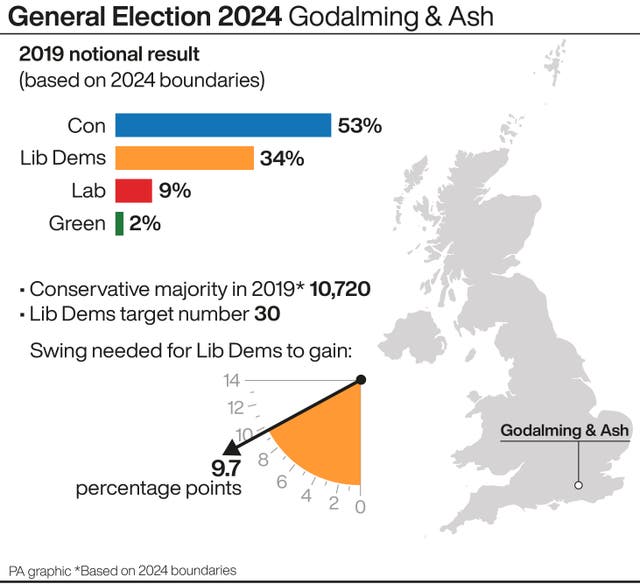
The south east of England – outside London – is historically one of the safest areas of the country for the Conservatives, but this election has seen other parties target the region for potential gains and the chance to defeat some Tory big beasts.
A redrawing of boundaries has given the South East 91 constituencies, up from 84 in 2019, and had the last election been fought on these new boundaries it is calculated the Conservatives would have won 81 seats, Labour eight, the Liberal Democrats one and the Greens one.
Notional results for the 2019 election based on the 2024 boundaries have also been calculated, in order to determine the scale of the challenge facing candidates this time, and it is these majorities that are used below.
Some of the majorities being defended by the Conservatives in the South East are enormous – in 22 of the 81 seats they are larger than 20,000.
But there are also 15 Tory defences with majorities under 10,000, and it is here that both Labour and the Liberal Democrats will hope to clock up some success.

Labour’s top target in the region is Wycombe, which has been won by the Conservatives at every general election since 1951, but where Northern Ireland minister Steve Baker – who has held the seat since 2010 – is defending a notional majority of just 1,494.
The seat would change hands on a direct swing from Conservative to Labour of 1.6 percentage points.
Seven more seats would fall to Labour if Sir Keir Starmer’s party was able to push the swing up to 10 percentage points, including Southampton Itchen (previously held by Labour from 1992 to 2015), Hastings & Rye (1997 to 2010) and Worthing East & Shoreham, which has returned a Conservative MP at every election since the constituency was established in 1997.
Another of the seats that would change hands on a 10-point swing, Crawley, is an example of a so-called “bellwether”, which means the result in the constituency has a habit of matching the overall result of the general election – in this instance, at every election since 1983.
The seat with the longest track record of being a bellwether in the region, and also in the whole of the UK, is Dartford.
Since 1964, whichever party wins Dartford has also gone on to form the government.
Labour would need a swing of 15.9 percentage points to win the seat this time, where the Tories are defending a majority of 14,704.
A slightly larger majority of 15,780 is being defended by Leader of the House of Commons Penny Mordaunt in the constituency of Portsmouth North.
She is one of a number of high-profile Conservative candidates in the South East who could lose if both Labour and the Lib Dems perform exceptionally strongly.
A huge swing of 17.2 percentage points would be needed for Labour to win Portsmouth North, though the party has achieved bigger swings at recent by-elections.
Education Secretary Gillian Keegan is another example of a government minister possibly under threat, this time from the Liberal Democrats, who need a swing of 19.3 points to defeat her in Chichester.

But the biggest of big beasts potentially at risk in the South East is Chancellor of the Exchequer Jeremy Hunt, who is standing in the new seat of Godalming & Ash.
The Lib Dems need a smaller swing to win here – 9.7 percentage points – and Mr Hunt’s notional majority is 10,720.
The top target for Sir Ed Davey’s party in the region is Eastbourne, which they last held between 2010 and 2015 and again from 2015 to 2017.
A much smaller swing is needed here – 2.2 points – than the one that would defeat Jeremy Hunt or Gillian Keegan.
A total of 10 Tory defences would fall on a direct swing to the Liberal Democrats of 10 percentage points, including Eastleigh, Lewes and Winchester – all former Lib Dem strongholds – with Godalming & Ash being the tenth.
The one constituency the Lib Dems are defending in the South East is Oxford West & Abingdon, where Layla Moran is hoping to hold the seat she first won in 2017.
The eight seats Labour are defending are mostly in built-up areas or locations with large student populations: Brighton Kemptown & Peacehaven, Canterbury, Hove & Portslade, Oxford East, Portsmouth South, Reading Central, Slough and Southampton Test.
The party’s most vulnerable seat is Canterbury, where Rosie Duffield is defending a notional majority of 2,160, with the Tories the main challenger.
South-east England is also home to the only Westminster parliamentary constituency ever won by the Green Party: Brighton Pavilion.
Caroline Lucas first won the seat in 2010 and held it at the 2015, 2017 and 2019 general elections, but she is not standing this year.
Sian Berry, a former Green member of the London Assembly, is the party’s candidate at this election, with seven others on the ballot paper including Labour – which is hoping to win back the seat it held from 1997 to 2010 – and an artificial intelligence-generated candidate called AI Steve, the alter ago of real-life independent candidate Steve Endacott.
The Greens are defending a substantial majority of 19,630 in Brighton Pavilion.
All notional majorities and swings mentioned above have been compiled by professors Colin Rallings and Michael Thrasher of the University of Plymouth, on behalf of BBC News, ITV News, Sky News and the PA news agency, and will be used as the basis for reporting the gains and losses at the General Election.


Comments: Our rules
We want our comments to be a lively and valuable part of our community - a place where readers can debate and engage with the most important local issues. The ability to comment on our stories is a privilege, not a right, however, and that privilege may be withdrawn if it is abused or misused.
Please report any comments that break our rules.
Read the rules here